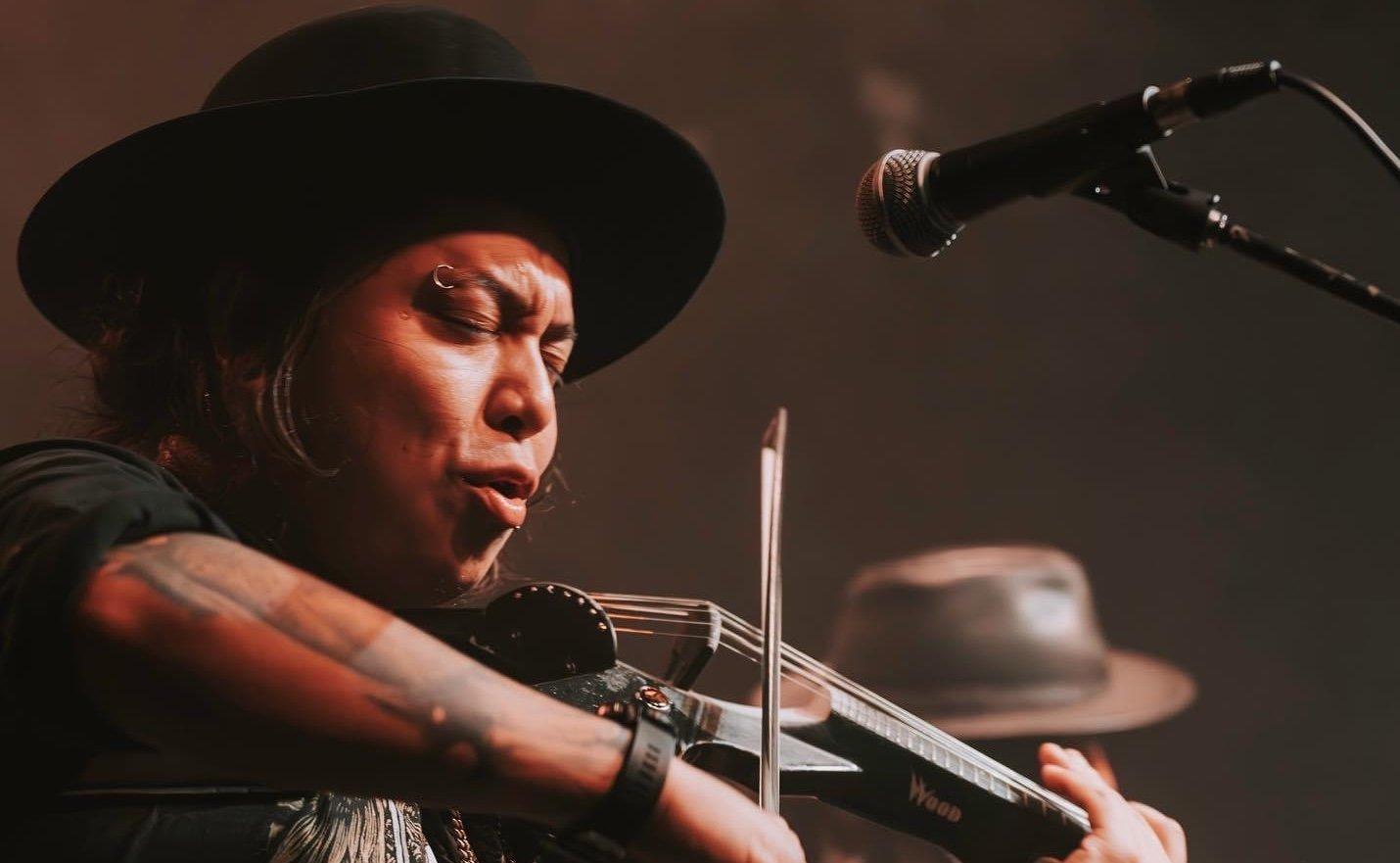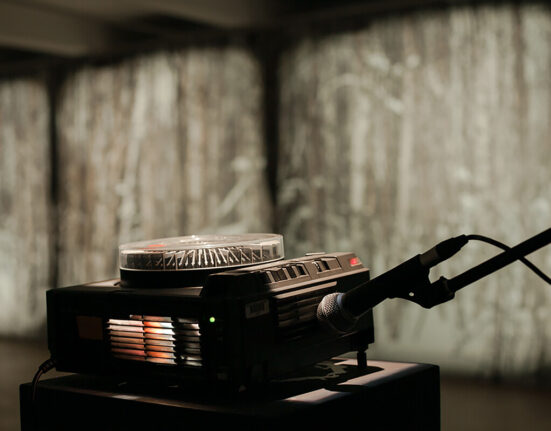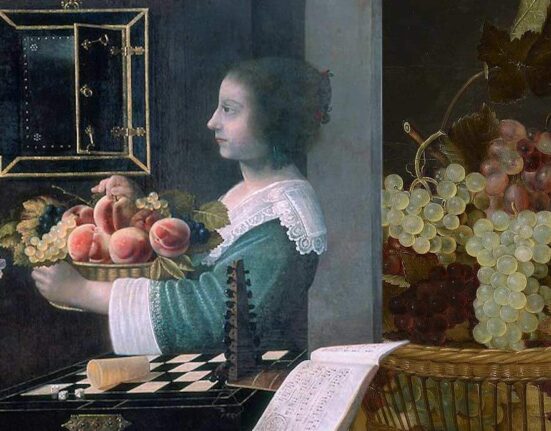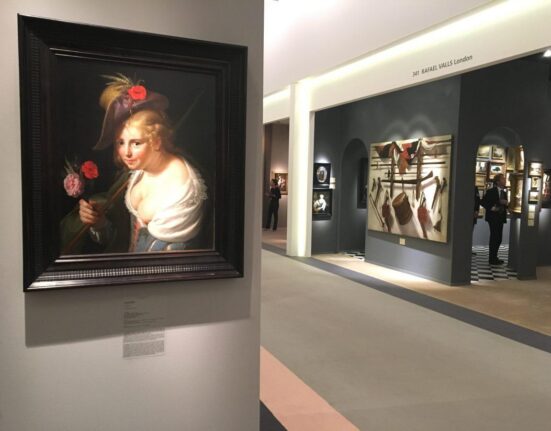A festival promoter told Delbert Anderson he didn’t present as Indigenous enough. The trumpeter and his group, DDAT, showed up to the State Fair of Texas in what he calls “the Native American section” — filled with dancers in traditional garb, among other signifiers. DDAT, for their part, donned suits.
“They immediately assumed that we had some type of traditional feather show,” Anderson, who is of Diné and Navajo descent, tells GRAMMY.com. “They probably thought we were going to show up in regalia or something.”
The promoter asked Anderson whether or not DDAT played traditional music. “No, we don’t,” he responded. “But there are a lot of melodies that are inspired from that.” The promoter didn’t comprehend this — so much so that she went up to Anderson mid-set and shoved a turquoise necklace around his neck.
Anderson was shocked. “I kind of stopped and said, ‘Excuse me,'” he recalls. “And she just sort of said, ‘You don’t look Native enough.'”
https://www.youtube.com/watch?v=/m5KlG7U7JxQ
Read More: Meet Delbert Anderson, A Native American Trumpet Master Interweaving Navajo Melodies With Jazz
Ever good-humored, Anderson brushed off the harassment and tossed the necklace around his white bass player’s neck. Still, he can’t get the incident out of his head. “That’s one of the first times anything like that has happened to me,” he says. “They expect that kind of back-to-the-roots, traditional type of music from anyone who uses the words ‘Native,’ ‘Indigenous’ or ‘tribal.'”
He’s not alone: Many musicians of Indigenous ancestry in his circle — and outside of it — have felt the micro- and macroaggressions come fast and hard. And othering those who identify and market themselves as Indigenous isn’t exclusive to jazz.
Even though Indigenous peoples have been here longer than anyone, they face tension, discomfort and/or unadulterated racism in a slew of genres understood to be American — from country to blues to gospel to hip-hop.
This is despite the fact that all these genres have deep Indigenous roots. Jazz household names Charlie Parker and Thelonious Monk had Native American ancestry. Same with blues musicians like Howlin’ Wolf, Charley Patton and Martha Redbone. In classic rock, you’ve got Jimi Hendrix and Robbie Robertson. The list goes on.
Renata Yazzie. Photo: Darklisted Photography
Despite this, Diné classical pianist Renata Yazzie says moving through her world is a “scabrous” experience. “The greatest difficulty is not only teaching ignorant people, but willfully ignorant people who refuse to recognize how the elitism of classical music has affected historically underrepresented groups,” she tells GRAMMY.com.
Why do musicians who identify as Indigenous, like Anderson, Yazzie, Mali Obomsawin, Adrian Wall, JJ Otero, James Pakootas, Julia Keefe, Warren Realrider and Raven Chacon — all of whom spoke to GRAMMY.com for this story — experience such tension, both from within their communities and in the wider world?
The answers are manifold, varying wildly between artists and their tribal affiliations. Here are some of the ways that artists of Indigenous descent have experienced unease in the American music landscape — and how they overcame it.
Howlin’ Wolf. Photo: Gilles Petard/Redferns via Getty Images
Considering The Course Of History
Since time immemorial, Indigenous peoples have developed an impossibly broad array of musical traditions. And with the arrival — or invasion, depending on who you ask — of European settlers came trade, fighting over boundaries and the introduction of European instruments.
At mission schools, Europeans taught Native Americans to compose on European instruments. This led to students composing Indigenous usic with those tools and methods. Works like 1845’s Indian Melodies featured traditional Native tunes composed with European notation.
In the back-half of the 19th century, the primordial stew of Black American music was percolating — the one that would give the world jazz, blues and other idioms. And the pervasive invisibility felt by Indigenous peoples meant they had a point of commiseration with Black musical communities.
“Black and Indigenous people have been in community with each other since the beginning, since Black Africans were forcibly brought here for slavery,” jazz bassist Mali Obomsawin, who is affiliated with the Odanak Abenaki First Nation tribe, tells GRAMMY.com. “I think people tend to forget that many of the founding blues and jazz artists were both Black and Native.”
This confluence of heritages and traditions has been obscured by what Obomsawin calls a larger obfuscation of Indigenous identity — coupled with anti-Blackness. “If someone like Thelonious Monk, who was Tuscarora, was to be like, ‘I’m Native American,’ everyone would be like, ‘No, you’re Black,'” Obomsawin says.
“It was not desirable for Natives to be higher in numbers, whereas it was desirable for Black folks to be higher in numbers because they were considered property,” she continues. “That means that slave owners and human traffickers had more property value. Whereas the more people that were Native, the more people the government was accountable to.”
Mildred Bailey. Photo: Bettmann/Contributor via Getty Images
Julia Keefe, a jazz vocalist and enrolled member of the Nez Perce tribe, is acutely aware of the crossroads of Blackness and Indigenousness in early American music.
“There is a historical precedent for Native Americans in jazz,” she tells GRAMMY.com, citing Indigenous people who learned European music in boarding and residential schools. “Around the same time that jazz was taking off in the ’20s and ’30s, there is evidence of Native people forming their own big bands.”
One lesser-known early Indigenous jazz musician was Mildred Bailey, a singer of Native descent from the Coeur d’Alene tribe.
“She was the first one to sing in front of a big band,” Keefe notes. “You think about all the female vocalists — Ella Fitzgerald, Billie Holiday, Sarah Vaughan — who got their start singing in front of big band, and it was because there was such an appetite for that sound by Mildred Bailey singing in front of the Paul Whiteman Orchestra.”
Oscar Pettiford. Photo: Michael Ochs Archives via Getty Images
But Bailey is just the tip of the iceberg in this regard. Besides Parker and Monk, there’s a lengthy list of jazz artists of Indigenous descent — including saxophonist Jim Pepper, bassist Oscar Pettiford and trumpeter and multi-instrumentalist Don Cherry.
And jazz is but one piece of the puzzle: Indigenous artists can be found in all genres. But at times, proudly broadcasting their heritage in these spaces has proved difficult in the face of divisive politics.
Navigating Political Divides
While Anderson can only speak for his local scene near Farmington, New Mexico, he has a clear vantage on what it’s like to market oneself as a Native American musician.
“I think as time progressed from the ’80s until now, there were a lot of stronger Indigenous voices that came out,” he says, citing activist causes like the American Indian Movement. “The moment you try to take any stand for Native American something, people tend to take those words as ‘You’re a hardcore activist.'”
“I mean, I could go outside right now and say, ‘I stand with Standing Rock,'” he adds. “Immediately, people are going to think of me as a negative force here.”
And while that scene comprised a healthy variety of perspectives and genres, it attracted judgement from the outside. “I think a lot of the people who were involved didn’t really realize what they were creating,” Anderson says. “It really looked like they were making some type of coalition — or Indigenous organization — that’s going to fight everything that goes in their path.”
Delbert Anderson. Photo: Maurice Johnson
This atmosphere weighed heavily on Anderson’s career in 2013, when DDAT began to market themselves as “Native American jazz.” (James Pakootas, their MC, is Indigenous; bassist Michael McCluhan is white; drummer Nicholas Lucero is Hispanic.)
“We immediately got thrown into this pool of musicians that were stirring up this big group or organization,” Anderson says. “The moment we said ‘We are Native American jazz,’ they immediately assumed we’re part of this Native American music scene, and it lost us gigs because they thought we were there to lecture the audience.”
Anderson saw his more militant colleagues as refusing to compromise, acting as if rules didn’t apply to them. “There’s a lot of that showing up in musicians today,” he says. “The moment a venue says something that they can’t do, like, ‘Oh, you can’t burn cedar here before the show,’ or anything like that, they’ll throw a huge, huge fit.”
“I hate to say it,” Anderson says, “but it kind of ruined it for the rest of us who don’t participate in that ceremony.”
To avoid these associations, DDAT eventually decided to pivot away from “Native American jazz,” describing themselves as a funk/jazz group inspired by Indigenous melodies. “People started to see us as not being activists, or the rowdy ones,” Anderson says. As a result, the group immediately started getting offered more gigs.
Julia Keefe. Photo: Don Hamilton
Braving Inner Conflict
This dissonance isn’t limited to sociopolitical factions, or a conflict between musicians and promoters — although Anderson could certainly share other horror stories. Even so-called enlightened spaces, like jazz workshops, have left Indigenous musicians second-guessing themselves.
“At gigs or at workshops or what have you, people will come up and be kind of aggressive about it — almost offended,” Keefe says. “Like, [Flustered voice] ‘What does that mean? What do you mean you are a Native American jazz vocalist?’ ‘Well, I’m Native American and I sing jazz. That’s what I do.'”
“With that confrontation of my identity,” she adds, “there’s been tension within myself of, ‘If I’m going to claim my Native heritage on my business card, should my music be more influenced by my Indigenous heritage?'”
But even if an artist defines what Indigenousness means for themselves, it’s bound to create friction with others’ preconceptions or stereotypes. “That’s something that Natives come up against in any sort of art form,” Obomsawin says.
Adrian Wall. Photo: Shondinii Walters
Adrian Wall, a flutist and guitarist with roots in the Jemez Pueblo tribe, experiences dislocation just by announcing who he is to the world.
“Once you play the Native card, you’re kind of stuck being a Native musician when you’re actually playing music that’s accepted worldwide just as American music,” he tells GRAMMY.com. “Once you call yourself a Native, all of a sudden you’re playing Native music.”
Raven Chacon, a Diné composer who works in the experimental and noise scenes, has had to push against assumptions that his work would be stereotypically Native — or adjacent to new age.
“There was an assumption it was going to involve flutes or drums or something,” he tells GRAMMY.com with a laugh. “Even from people should know better, there have been assumptions.”
Raven Chacon. Photo: Jamie Drummond
To fellow experimental musician and sound sculpturist Warren Realrider — who is Pawnee and enrolled with the Crow Nation of Montana and makes music akin to John Zorn, Pauline Oliveros and Merzbow — the solution lies in creating a music industry framework that accurately represents Indigenous creators.
“These systems of music, distribution, performance, whatever — they are built on a world that’s not the Indigenous world,” he tells GRAMMY.com. “You’re always going to have to work against that in some way.”
Plus, as a representative of his background in the insular noise space, Realrider’s work has become bigger than him — he feels inordinate pressure to not let his tribe down.
“A lot of Indigenous artists don’t lose that aspect,” he says, considering the arc of his life and career so far. “That’s something you carry along with you, and you present yourself that way.”
Addressing Language Barriers
Sometimes, the criticism comes from within Indigenous communities themselves. JJ Otero, a Hopi and Diné singer/songwriter inspired by bands like Counting Crows and Pearl Jam, had to deal with the finer points of language — even one he knew backward and forward.
“I didn’t use the Navajo language in my music for the longest time,” he tells GRAMMY.com from his home on a Navajo reservation. “The white guys in [my first band, Saving Damsels] said, ‘You should write a song in Navajo that we can play.'”
JJ Otero. Photo: Unek Francis
Despite being a fluent Navajo speaker, Otero wanted to be careful that he said things exactly right. “I don’t want my songs to just be a lazy utterance of words in Navajo,” he says. To thread the needle, Otero enlisted his father to vet his lyrics for inexact grammar and syntax.
“I do believe that sometimes our own people can be our toughest critics,” Otero says. “We can take that criticism and be mad and upset about it, or we can dive deeper into why those criticisms exist and understand the foundation of why Navajo is sacred.”
Facing One’s Own Community
As a rapper and motivational speaker who spits bars in DDAT, James Pakootas operates by what he calls “a very deep awareness of protocol.”
“A lot of times, Native artists in contemporary music want to meld the two worlds, but it seems like sometimes they’re taking away from the culture. It’s not done with care,” Pakootas tells GRAMMY.com. “It’s like sampling a powwow song, putting it on a hip-hop beat and calling it good.”
James Pakootas. Photo: Maurice Johnson
To avoid this sort of mishandling, Pakootas works with collaborators to tell his stories as considerately as possible, preferring to bring in a drum group and analyze together how the story could be told.
“A lot of songs I know are ceremony songs,” he adds. “There’s not going to be any of those that I share because there’s a protocol in place to keep that sacred. There’s a time and a place for that song to be sung or that melody to be used.”
Reaching Harmony From Dissonance
How can music fans right these wrongs and push against the othering of Indigenous artists? Maybe the first step is realizing that Indigenous music is all music.
“Native people are very much seen as mythological creatures, as the villains in Westerns, the mascots that you love to hate, or whatever,” Keefe says. “So, I can see why [musical discrimination] would be a thing because so often we are perceived as a figment of someone’s imagination.”
Warren Realrider. Photo: Shane Brown
For Obomsawin, this necessary shift begins with education — and by listening to the stories of her elders. In her case, that teacher is Pura Fé, a Tuscarora and Taino vocalist and activist related to Thelonious Monk.
“She is so intimately aware of those dual legacies — the Black and Native lineages of jazz,” Obomsawin says. “I just hope that more air time is given to the elders in the jazz and blues community who know those things. I think it could really help to unearth some of those stories as really important parts of American music history — as well as our history in general.”
Mali Obomsawin. Photo: Nolan Altvater
As for Yazzie, she believes significant change won’t occur until we give sovereignty to Indigenous artists — so they can decide who their audience is, why they perform their music, what their music sounds like, where they want their music played, and how they want it to be perceived by the rest of the world.
“I always maintain that Native music is Native music because a Native person is outputting it,” Yazzie says. “But on the flipside, you don’t want to limit people to where all they do is Native music. I think you have to be really careful to not use the Native music label as a way to put people in a specific box. Because Native music is still also blues. It’s still jazz. It’s still country. It’s still hip-hop. It’s still classical music. [Indigenous] people are in those genre-specific spaces and they’re doing amazing things.”
https://www.youtube.com/watch?v=/GZHgZ1K7V7s
When considering this subject, Anderson always returns to Don Cherry, who remains one of his idols. “In one of his interviews, he said, ‘Hey, it’s about meeting other people. It’s about having relationships with your friends,'” he says.
“I think everyone just needs to go back to their original state, going back to just being a human and recognizing that we’re all humans here,” Anderson adds. “Approach each other as human beings with our minds or our thoughts.”
Anderson is bringing Cherry’s openhearted philosophy to his next endeavor — collaborating with the American Pops Orchestra for a Bureau of Land Management project. This has been a laborious process, with no shortage of fine lines to navigate.
“Bringing this orchestra onto the Indigenous lands is going to be a real struggle because of all the racial division going on in the world,” he says. But in the end, Anderson believes all the work is going to be worth it.
“Having these two different identities on that land, I’m hoping the land can really heal the group that’s there,” he says. “I mean, if the land really heals, we’re going to put the land to the test.”
Because it’s happened before on this soil: Indigenous people and those of so many other backgrounds have come together to make great American music. Sure, it’s been a rocky path to get there — sometimes a troubling and treacherous one. But Anderson and his colleagues aren’t afraid to tread it.
Commonalities, Subtleties & Purpose: 7 Musicians Pushing Ancient Asian Instruments Into The Future







